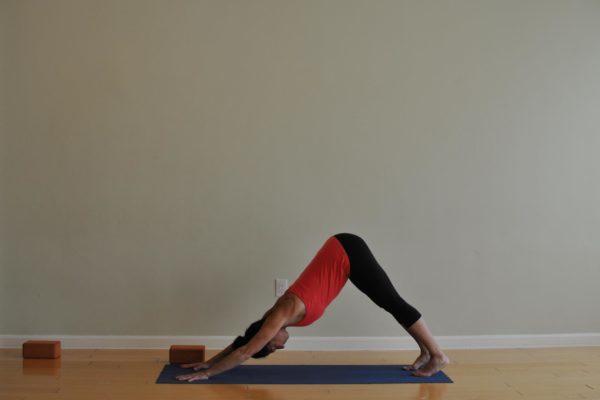
I was talking to a student after class the other day and he was confused about the action of his shoulders in a few different positions. He asked about the shoulders in both Downward Dog, Wheel and moving from High to Low Push Up. One of the things that struck me was that he mentioned attending regular classes where teachers were suggesting that he “relax his shoulders while in Downward Dog.” He began to demonstrate it for me, while in the pose and I could see how this could be a very confusing cue for a student to hear.
What happened as he tried to “relax his shoulders” in the pose was that he ended up internally rotating his shoulders and slightly turning his hands in. This resulted in more of a “collapse” in the pose versus a “pushing off the floor” action.
So, why am I writing about this? Because it demonstrates how important it is for we as teachers to be sure that what we are saying makes sense and, well, is correct. Now, some of you reading this might say, “Well, it IS important to relax the shoulders in Downward Dog!” Why would you want someone to create stress in that part of the body as they’re in the pose?”
Of course, we don’t want to suggest that students create stress or let’s say, “scrunch” their shoulders up to their ears while in Downward Dog. But it does suggest that cueing to “relax the shoulders” while in this particular pose might not be the best choice of words.
There are many different cues we can use when teaching yoga. My focus in teaching is on the anatomy so most of my cues are physical and refer to anatomical movements and straightforward actions a student should make while in the posture. Does that mean that there are opportunities for a student to misunderstand what I’m saying or interpret it differently than my intention? Of course! But we minimize that when we speak in concrete terms. We also minimize confusion when we, as teachers, understand what is going on in a particular pose from an anatomical standpoint. Let’s face it, these poses are anatomy in action. If we don’t get what’s going on, how can we effectively cue students?
I remember when I first began teaching, I was taught about alignment. I knew the knee should be over the heel in Warrior 1 but I had no idea why. I knew the shoulders should be over the wrists in Upward Dog and the elbows over the wrists in Crow, but didn’t understand why that made a difference. When we understand the anatomy behind the poses, we are better able to cue, answer questions and adjust students.
I’ll give you another example. I remember for many years, I’d take classes and teachers would suggest to “relax the shoulders in Warrior 1.” So, students would drop (depress) their shoulders as they were reaching their arms up to the sky. While they were indeed “relaxing their shoulders,” they were actually fighting the natural movement of the shoulder blades (scapula) to elevate as one lifts the arm. So, this cue is a fairly common mis-cue from an anatomical standpoint.
I always mention that as teachers we have lots of things to choose from when it come to emphasis. Some teachers really don’t like the anatomical focus and prefer to focus on spirit, chakras, personal growth.. the list goes on. Despite that, on some level, we’re all focused on the anatomy because yoga practice, asana, the physical practice, is indeed physical. There’s no getting around it. The more we understand what’s going on, the better we’re able to create purposeful action in the body.
When I work with new teachers, I suggest that they only say what they can explain, should a student ask a question. So, if I go to a class and someone says, “Roll the upper arm bones out” as we’re in Downward Dog and I don’t get why that is helpful, it wouldn’t make sense for me to say that as I teach, until I have a chance to figure out why that’s a helpful cue (this cue is sometimes used to create a bit of external rotation/action of the teres minor muscle while in Downward Dog.. it’s actually the opposite of the “relax” cue mentioned at the start of this post).
If you’re new to yoga anatomy or just learning it, what can be helpful is to stick with concrete action words while teaching. Words like “press, push, lift, root, draw in, squeeze, lengthen, contract” are helpful words to offer. As always, the study of anatomy is a life long process but there are lots of things you can do along the way to expand your knowledge.
If you enjoy posts like these, you might be interested in my anatomy 3 pack of PDF’s that provide cues for backbending and postures of the hip and neck. You can get those here:
Interested in receiving a 3-PDF Teacher’s Yoga Anatomy Kit? Click here!
